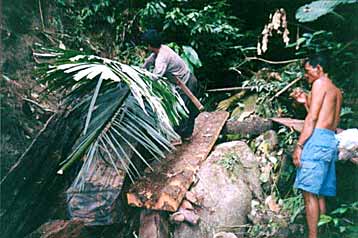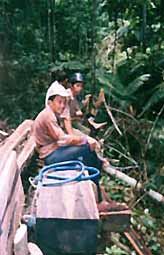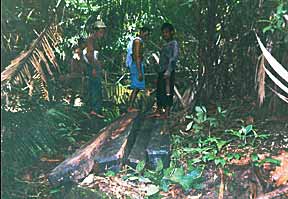HARVESTING MACASSAR
HOME ORDER ONLINE PRODUCTS REGISTER CONTACT US

Photos taken in Indonesia by David Schroader during the harvest of the Macassar ebony cants. The backs and sides shown below came from these cants.Macassar Ebony has been harvested from Sulawesi, Indonesia for probably 150 years now. As a consequence, the mature trees are farther and farther back up in the mountains. Because Sulawesi is still quite undeveloped, harvesting takes place by hand. The terrain is quite steep and roads into the interior are almost non-existent.
First, the tropical forests there are diverse and do not at all exhibit what we know in this country as a tree species-depauperate “climax forest” in which a relatively few species “succeed” others to result in their eventual abundance and predominance
(for instance “oak-hickory association” in the central U.S.). In, perhaps, four hectares of forest in Sulawesi there may be 250 species of trees in an uneven-aged stand. In the small areas of the jungle we harvest, of this extraordinarily huge variety, essentially one species is being harvest for export—that being Macassar Ebony. One mature ebony tree might be found in one location and the next mature ebony tee another 200 meters up the hill and another mature ebony tree 300 meters over the next ridge. Harvesting just one tree here and one there simulates the natural forest process of “gap dynamics” whereby one large tree or a very small number may die of old age, disease, wind throw, lightning strike, etc.
Further, because there are no access roads or trails to these interior forests, trees are harvested literally by hand. Selected trees are felled and dragged downhill by manpower. Slings affixed to the shoulders of workers accomplish this.
As ebony is extremely heavy and difficult to drag by local villagers, the very narrow band of white wood (sapwood), prone to subsequent insect infestation, on the outside of the log under the bark is cut off, the very center of the log (heart) is cut out because the hearts are dimensionally unstable and crack, and the “square logs”, or “cants” are dragged downhill by manpower to the nearest trail. At this trail, the cant is generally attached to a domesticated buffalo, which further drags the cant to the nearest village or primitive road.
A high percentage of the export revenues are consequently retained by the local harvesting villagers, rather than going into the hands of seemingly innumerable government officials.
Finally, this method of harvesting could not possible be of lower impact, and the tropical forests in Sulawesi are left, both during and after harvest, altogether intact.

Address General Information
Sales/support Telephone:
707-431-3760 POB 217, 101 C Grant Avenue, Healdsburg, Ca. 95448 USA [email protected] [email protected] Fax:
707-431-3762





